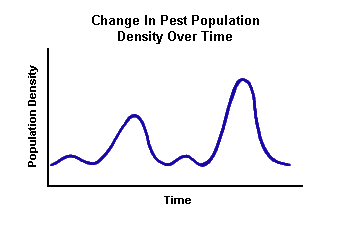Economic Injury Level
From Different Viewpoints
Infestations of the gypsy moth (Lymantria dispar) provide a good case study of how the economic injury level might change based on the viewpoint of four different stakeholders:
 Stakeholder #1 is a campground owner. His livelihood depends on a seasonal tourist trade, and much of his business comes from repeat customers who enjoy the peace and tranquility of his campground. An infestation of gypsy moths will cause defoliation in many of the hardwood trees, fecal pellets will accumulate on top of the picnic tables, and cocoons will cover tree trunks and walls of the showerhouse. The economic injury level for this stakeholder would be very low: any infestation that discourages campers from returning next year is unacceptable.
Stakeholder #1 is a campground owner. His livelihood depends on a seasonal tourist trade, and much of his business comes from repeat customers who enjoy the peace and tranquility of his campground. An infestation of gypsy moths will cause defoliation in many of the hardwood trees, fecal pellets will accumulate on top of the picnic tables, and cocoons will cover tree trunks and walls of the showerhouse. The economic injury level for this stakeholder would be very low: any infestation that discourages campers from returning next year is unacceptable.
Stakeholder #2 is the owner of a lumber company. Aesthetics are not an issue. She is interested in maximizing board feet of lumber harvested from the forest during the twenty-year duration of her timber lease. She will tolerate an infestation of gypsy moths, but only up to the point where it begins to defoliate the trees and reduce their growth. Her economic injury level is higher than that of the campground owner.
Stakeholder #3 is a municipality with interests in the forest as a watershed for the city’s supply of drinking water. Defoliation can be tolerated as long as there is no widespread tree death. The economic injury level for this stakeholder will be very high.
Stakeholder #4 is a park ranger who manages the forest as a wilderness area. By law, the land cannot be inhabited by humans or managed as a timber resource. Nature will run her course and it is unlikely that gypsy moths will ever exceed the economic injury level.

